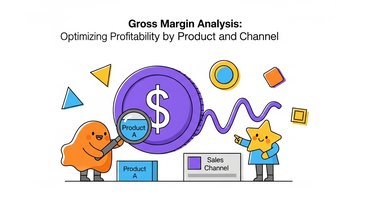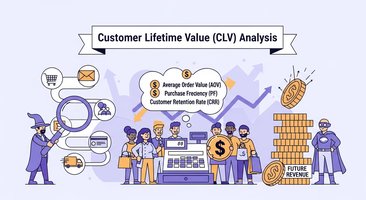Running a successful ecommerce business in 2025 requires more than just great products and marketing campaigns. With over 2.14 billion people expected to buy goods and services online this year, the competition is fierce, and data-driven decision making has become the difference between thriving businesses and those that struggle to survive.
The key to sustainable ecommerce growth lies in tracking the right Key Performance Indicators (KPIs). These metrics provide crucial insights into customer behavior, financial performance, operational efficiency, and growth opportunities. However, with hundreds of potential metrics to monitor, knowing which ones truly matter can be overwhelming.
This comprehensive guide reveals the 20 most critical ecommerce KPIs that every business owner should track in 2025, organized into four essential categories: Revenue & Profitability, Customer Acquisition & Retention, Conversion & Engagement, and Operational Efficiency.
Why Ecommerce KPIs Matter More Than Ever in 2025
The ecommerce landscape has evolved dramatically. Rising customer acquisition costs, increased competition, and changing consumer behaviors have made it essential for businesses to optimize every aspect of their operations. According to recent industry data, businesses that actively track and optimize their KPIs see 23% higher revenue growth compared to those that don't.
Modern ecommerce KPIs serve three critical purposes:
Performance Monitoring: Track what's working and what isn't across all business functions
Predictive Insights: Identify trends and opportunities before they become obvious to competitors
Strategic Decision Making: Make data-driven choices that drive sustainable growth
The challenge isn't just tracking these metrics—it's having them automatically calculated and presented in a way that enables quick, informed decisions. This is where advanced analytics platforms like Klavena become invaluable, automatically syncing data from all your sales channels and providing real-time insights.
Revenue & Profitability KPIs
These fundamental metrics measure your business's financial health and growth trajectory.
1. Monthly Recurring Revenue (MRR) and Growth Rate
Monthly Recurring Revenue tracks the predictable revenue your business generates each month. For ecommerce businesses with subscription components or repeat customers, MRR provides stability insights.
How to Calculate: Sum of all recurring revenue normalized to a monthly amount
Benchmark: Healthy ecommerce businesses aim for 10-20% month-over-month MRR growth
Why It Matters: MRR helps predict cash flow and business sustainability, making it easier to plan inventory, marketing spend, and expansion strategies.
2. Average Order Value (AOV)
Average Order Value measures the average amount customers spend per transaction.
How to Calculate: Total Revenue ÷ Number of Orders
Benchmark: AOV varies by industry, but the average across all ecommerce is approximately $128
Optimization Strategies: Bundle products, offer free shipping thresholds, implement upselling and cross-selling tactics
Klavena automatically tracks AOV across all your sales channels, showing you which platforms and customer segments generate the highest order values.
3. Customer Lifetime Value (CLV)
CLV predicts the total revenue a customer will generate throughout their relationship with your business.
How to Calculate: (Average Order Value × Purchase Frequency × Customer Lifespan)
Benchmark: A healthy CLV should be at least 3x your Customer Acquisition Cost
Strategic Impact: CLV helps determine how much you can spend on customer acquisition while maintaining profitability
4. Gross Profit Margin
Gross Profit Margin shows the percentage of revenue remaining after subtracting the cost of goods sold.
How to Calculate: (Revenue - Cost of Goods Sold) ÷ Revenue × 100
Benchmark: Healthy ecommerce businesses maintain 40-60% gross margins
Critical Insight: This metric reveals your pricing strategy effectiveness and operational efficiency
5. Return on Ad Spend (ROAS)
ROAS measures the revenue generated for every dollar spent on advertising.
How to Calculate: Revenue from Ads ÷ Ad Spend
Benchmark: A ROAS of 4:1 or higher is generally considered profitable
Platform Variation: ROAS can vary significantly across advertising platforms, making channel-specific tracking essential
Customer Acquisition & Retention KPIs
These metrics focus on how effectively you attract and keep customers.
6. Customer Acquisition Cost (CAC)
CAC represents the total cost of acquiring a new customer, including marketing, advertising, and sales expenses.
How to Calculate: Total Acquisition Costs ÷ Number of New Customers Acquired
Benchmark: CAC should be significantly lower than CLV (ideally 1:3 ratio)
Hidden Costs: Many businesses underestimate CAC by not including all associated costs like marketing team salaries and tools
7. Customer Retention Rate
This metric measures the percentage of customers who make repeat purchases over a specific period.
How to Calculate: ((Customers at End of Period - New Customers) ÷ Customers at Start of Period) × 100
Benchmark: The average ecommerce retention rate is around 27-30%
Impact: Increasing retention rates by just 5% can increase profits by 25-95%
8. Repeat Purchase Rate
Repeat Purchase Rate shows the percentage of customers who make more than one purchase.
How to Calculate: Number of Customers with Repeat Purchases ÷ Total Number of Customers × 100
Benchmark: Varies by industry, but 20-30% is considered healthy for most ecommerce businesses
Growth Strategy: Focus on post-purchase email sequences and loyalty programs to improve this metric
9. Net Promoter Score (NPS)
NPS measures customer satisfaction and likelihood to recommend your business.
How to Calculate: % Promoters (9-10 ratings) - % Detractors (0-6 ratings)
Benchmark: An NPS above 50 is excellent, above 70 is world-class
Predictive Power: NPS strongly correlates with future revenue growth and customer retention
10. Churn Rate
Churn Rate measures the percentage of customers who stop buying from your business.
How to Calculate: Lost Customers ÷ Total Customers at Start of Period × 100
Benchmark: Aim for monthly churn rates below 5-7%
Early Warning: High churn rates often indicate product, service, or customer experience issues
Conversion & Engagement KPIs
These metrics reveal how effectively your website and marketing efforts convert visitors into customers.
11. Conversion Rate
Conversion Rate measures the percentage of website visitors who complete a desired action (usually making a purchase).
How to Calculate: Number of Conversions ÷ Number of Visitors × 100
Benchmark: The average ecommerce conversion rate is 2.5-3%
Optimization Focus: Small improvements in conversion rate can have massive impact on revenue
12. Add-to-Cart Rate
This metric shows the percentage of product page visitors who add items to their shopping cart.
How to Calculate: Number of Add-to-Cart Actions ÷ Number of Product Page Views × 100
Benchmark: A healthy add-to-cart rate ranges from 8-12%
Insight: Low add-to-cart rates often indicate pricing, product description, or trust issues
13. Cart Abandonment Rate
Cart Abandonment Rate measures the percentage of shoppers who add items to their cart but leave without purchasing.
How to Calculate: (Number of Completed Purchases ÷ Number of Shopping Carts Created) × 100
Benchmark: The average cart abandonment rate is around 70%
Recovery Opportunity: Abandoned cart email campaigns can recover 10-15% of lost sales
14. Email Open Rate
Email Open Rate measures the percentage of recipients who open your marketing emails.
How to Calculate: Number of Emails Opened ÷ Number of Emails Delivered × 100
Benchmark: The average ecommerce email open rate is 15-20%
Critical Factor: Subject lines and sender reputation significantly impact open rates
15. Click-Through Rate (CTR)
CTR measures the percentage of people who click on your ads or email links.
How to Calculate: Number of Clicks ÷ Number of Impressions × 100
Benchmark: Email CTR averages 2-3%, while Google Ads CTR averages 2-5%
Optimization: A/B test different ad copy, images, and calls-to-action to improve CTR
Operational Efficiency KPIs
These metrics help optimize your business operations and customer experience.
16. Inventory Turnover Rate
Inventory Turnover Rate measures how quickly you sell and replace inventory.
How to Calculate: Cost of Goods Sold ÷ Average Inventory Value
Benchmark: Most ecommerce businesses should aim for 4-6 inventory turns per year
Cash Flow Impact: Higher turnover rates improve cash flow and reduce storage costs
17. Order Fulfillment Time
This measures the time between order placement and shipment.
How to Calculate: Average time from order confirmation to shipment
Benchmark: Same-day or next-day fulfillment is becoming the standard
Customer Expectation: 61% of customers expect delivery within 1-3 business days
18. Return Rate
Return Rate measures the percentage of orders that customers return.
How to Calculate: Number of Returned Orders ÷ Total Number of Orders × 100
Benchmark: The average ecommerce return rate is 8-10%
Cost Impact: High return rates significantly impact profitability and customer satisfaction
19. Customer Support Response Time
This measures how quickly your team responds to customer inquiries.
How to Calculate: Average time from inquiry receipt to first response
Benchmark: Aim for response times under 24 hours, ideally within 2-4 hours
Satisfaction Correlation: Faster response times strongly correlate with higher customer satisfaction
20. Website Load Speed
Website Load Speed measures how quickly your pages load for visitors.
How to Calculate: Average page load time across your website
Benchmark: Pages should load in under 3 seconds
Revenue Impact: A one-second delay in load time can reduce conversions by 7%
How Klavena Simplifies KPI Tracking
Managing 20+ KPIs across multiple sales channels, marketing platforms, and operational systems can be overwhelming. This is where Klavena's comprehensive analytics dashboard becomes invaluable for ecommerce business owners.
Automated Data Integration: Klavena automatically syncs data from all your sales channels (Amazon, Shopify, eBay, Etsy, etc.), eliminating manual data entry and ensuring accuracy.
Real-Time Dashboard: View all 20 KPIs in one centralized dashboard with real-time updates, making it easy to spot trends and opportunities immediately.
Custom Alerts: Set up automated alerts when KPIs move outside your target ranges, enabling proactive management.
Historical Analysis: Track KPI trends over time to identify seasonal patterns and long-term growth trajectories.
Channel Comparison: Compare performance across different sales channels to optimize your multichannel strategy.
Automated Reporting: Generate comprehensive reports for stakeholders without spending hours compiling data.
Setting Up Your KPI Tracking System
Successfully tracking these 20 KPIs requires a systematic approach:
- Prioritize Based on Business Stage
Early-stage businesses should focus on conversion metrics and customer acquisition
Growth-stage businesses should emphasize retention and operational efficiency
Mature businesses should optimize profitability and customer lifetime value - Set Realistic Benchmarks
Use industry averages as starting points but focus on improving your own historical performance
Set both short-term (monthly) and long-term (quarterly/annual) targets - Create Accountability
Assign ownership of specific KPIs to team members
Review KPI performance in regular team meetings
Tie KPI improvements to team incentives and bonuses - Automate Where Possible
Use platforms like Klavena to automate data collection and reporting
Set up automated alerts for critical KPI changes
Create scheduled reports for different stakeholders
Common KPI Tracking Mistakes to Avoid
Tracking Too Many Metrics: Focus on the KPIs that directly impact your business goals rather than trying to track everything
Ignoring Context: Always analyze KPIs in context—seasonal fluctuations, marketing campaigns, and external factors all impact performance
Not Acting on Insights: Tracking KPIs is worthless without taking action based on the insights they provide
Comparing Apples to Oranges: Ensure you're comparing similar time periods and customer segments when analyzing KPI performance
Focusing Only on Vanity Metrics: Prioritize KPIs that directly impact revenue and profitability over metrics that just look impressive
Conclusion: Your Path to Data-Driven Ecommerce Success
The 20 KPIs outlined in this guide provide a comprehensive framework for measuring and optimizing your ecommerce business performance in 2025. From revenue and profitability metrics that ensure financial health to operational KPIs that enhance customer experience, each metric plays a crucial role in your success.
The key to success isn't just knowing which KPIs to track—it's having the right tools and processes to monitor them consistently and act on the insights they provide. With platforms like Klavena automating the complex work of data collection and analysis, you can focus on what matters most: making strategic decisions that drive growth and profitability.
Remember, KPI tracking is not a one-time setup but an ongoing process of measurement, analysis, and optimization. Start with the metrics most relevant to your current business stage, establish your baseline performance, and gradually expand your tracking as your business grows.
The ecommerce businesses that thrive in 2025 will be those that master the art of data-driven decision making. By tracking these 20 essential KPIs and leveraging modern analytics tools, you'll be well-equipped to navigate the competitive ecommerce landscape and achieve sustainable growth.
Ready to transform your ecommerce analytics? Explore how Klavena's comprehensive dashboard can automate your KPI tracking and provide the insights you need to scale your business effectively.





